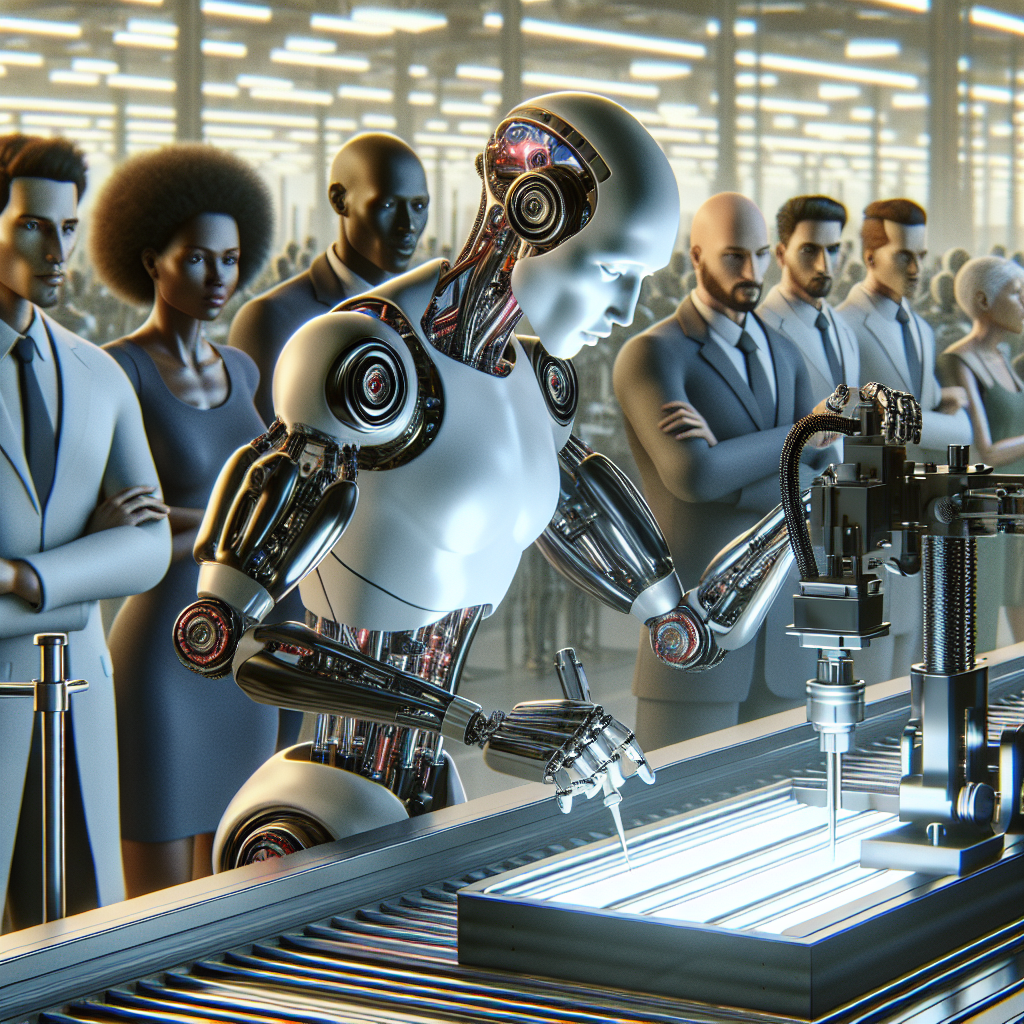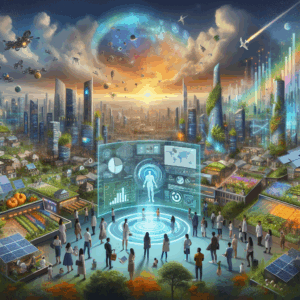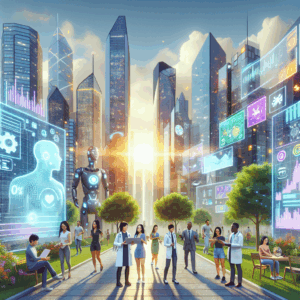Based on the research I’ve gathered, I’ll now write a comprehensive blog post on AI-driven job displacement and the future of work:
AI-Driven Job Displacement and the Future of Work
In an era of unprecedented technological advancement, artificial intelligence stands at the forefront of a transformation that’s reshaping not just industries but the very fabric of work itself. As AI systems become more sophisticated, questions about job displacement, economic restructuring, and the future of human labor have moved from theoretical discussions to pressing realities.
This blog explores the multifaceted impact of AI on employment landscapes, examining which sectors face disruption, the societal implications of these changes, and the strategies that individuals, organizations, and policymakers can implement to navigate this transition successfully.
The Scale of AI-Driven Job Displacement
The statistics surrounding AI’s potential impact on global employment paint a picture of significant transformation. According to research from multiple sources:
- By 2030, automation could displace between 400 and 800 million jobs globally, depending on the speed of adoption
- Up to 375 million workers (approximately 14% of the global workforce) may need to change occupations entirely
- The World Economic Forum projects that while 85 million jobs may be displaced by 2025, an impressive 97 million new roles could emerge
This dual nature of AI’s impact—simultaneously eliminating and creating jobs—highlights that we’re facing less of a job apocalypse and more of a profound labor market restructuring. The question isn’t whether jobs will disappear, but rather how the transition will be managed and who will bear the costs of this transformation.
Sectors Most Vulnerable to AI Disruption
AI’s impact varies significantly across different industries and job categories. Current data indicates several sectors face particularly high exposure:
Administrative and Data Processing
Administrative secretaries, data entry clerks, and basic office functions face some of the highest displacement risks. The World Economic Forum predicts that data entry clerk positions could decrease by approximately 8 million globally in the five years from 2023.
Financial and Accounting Services
Accountants, bookkeepers, and payroll clerks are projected to see a workforce reduction of around 4.75 million jobs. AI systems have demonstrated remarkable efficiency at handling routine financial transactions, calculations, and report generation.
Creative Industries
Surprisingly, creative fields face significant disruption. Goldman Sachs research suggests generative AI has the potential to automate approximately 26% of tasks in arts, media, and entertainment. This includes content creation, basic design work, and routine creative production.
Manufacturing and Logistics
Though already heavily automated in many regions, manufacturing continues to face AI-driven transformation. MIT and Boston University research suggests that by 2025, two million workers in manufacturing could be replaced by automated systems. Meanwhile, logistics is experiencing a complex shift with both job elimination and creation occurring simultaneously.
Geographic Distribution of Impact
The effects of AI job displacement will not be distributed evenly across regions:
- In five U.S. states—South Dakota, Kansas, Delaware, Florida, and New York—more than one in ten workers are considered highly vulnerable to AI-related automation
- Metropolitan areas in Florida and New York, including Tampa, Miami, Jacksonville, and Buffalo, face higher risks due to concentrations of workers in susceptible sectors
- Globally, developed economies may face greater immediate disruption, with up to 60% of jobs in advanced economies at risk compared to 26% in low-income countries
This geographic variance highlights how economic structures, industry concentrations, and existing technological integration levels will shape the pattern of AI’s impact.
Societal Implications and Inequality Concerns
Beyond raw employment numbers, AI-driven job displacement raises profound questions about economic equality and social cohesion:
Widening Economic Gaps
The transition to an AI-driven economy could exacerbate existing income inequality. Productivity gains and economic benefits may disproportionately flow to those who own the technology or possess the specialized skills to work with advanced AI systems.
Social Safety Net Pressures
Rapid job displacement could strain social welfare systems, particularly in regions with less robust unemployment support or retraining infrastructure. According to surveys, approximately two-thirds of Americans believe government action is necessary to prevent job losses due to AI.
Psychological and Community Impacts
Mass displacement in certain sectors or regions could lead to community-wide effects, including mental health challenges, social instability, and political polarization around technology policy. About half of Americans already express concern that increased AI use will lead to greater income inequality and a more polarized society.
Gender and Education Disparities
Research indicates that women and highly educated workers may face greater exposure to AI-related job changes, though they may also be better positioned to adapt to complementary roles working alongside AI.
Strategies to Address AI-Driven Job Displacement
While the challenges are significant, proactive responses can help manage the transition and maximize the benefits of AI while mitigating its disruptive impacts:
Education and Reskilling Initiatives
The most frequently cited response to AI displacement is comprehensive reskilling. Effective approaches include:
- Creating advanced reskilling programs focused on higher-level AI-related skills beyond basic digital literacy
- Reforming educational curricula at all levels to integrate skills that complement rather than compete with AI capabilities
- Establishing lifelong learning systems that enable continuous skill development throughout careers
- Providing financial support and incentives for workers pursuing retraining or education
Policy Interventions
Government policies play a crucial role in facilitating smooth transitions:
- Strengthening social safety nets to support workers during career transitions
- Implementing wage insurance programs to cushion income losses for those who shift to lower-paying sectors
- Creating targeted support for regions facing concentrated job losses
- Developing regulatory frameworks that encourage responsible AI deployment with consideration for employment impacts
Business Adaptation Strategies
Organizations can implement approaches that maximize AI’s benefits while supporting their workforce:
- Adopting augmentation strategies that use AI to enhance rather than replace human capabilities
- Investing in internal retraining programs for existing employees
- Creating transition paths that help workers move from disrupted roles to emerging positions
- Engaging in collaborative planning with employees about technology implementation
Promoting New Economic Opportunities
Beyond defensive measures, proactive creation of new economic paths is essential:
- Supporting entrepreneurship programs that leverage AI capabilities
- Investing in infrastructure and policies that enable new industry growth
- Exploring reduced work hours and flexible arrangements as productivity increases
- Considering universal basic income or similar approaches to address fundamental economic shifts
The Path Forward: Human-AI Collaboration
The most promising vision for the future of work isn’t one where AI simply replaces human labor, but rather where human-AI collaboration creates new possibilities. This collaborative future depends on intentional choices about how we develop and deploy AI technologies.
As researchers Daron Acemoglu and Simon Johnson note, “The consequences of any technology depend on who gets to make pivotal decisions about how the technology develops. This is doubly true for AI.”
The path that maximizes economic benefits while minimizing disruption will require:
- Prioritizing AI applications that complement human capabilities rather than primarily seeking to automate existing jobs
- Ensuring technological benefits are broadly shared across society
- Engaging diverse stakeholders in decisions about AI development and implementation
- Recognizing that technology deployment is a choice, not an inevitability
Conclusion
AI-driven job displacement represents one of the most significant economic transitions of our era. While the challenges are substantial, history demonstrates that technological revolutions typically create more jobs than they eliminate—though not necessarily for the same workers or in the same regions.
The key question isn’t whether AI will transform work—it will—but whether we can manage this transformation in ways that expand opportunity, reduce inequality, and enhance human potential. With thoughtful policies, adaptive education systems, and responsible deployment approaches, AI can become a powerful force for economic advancement rather than disruption.
The future of work in the age of AI remains unwritten. How this chapter unfolds depends less on the technology itself and more on the collective choices we make about how to harness its capabilities.
Sources & Further Reading
- World Economic Forum’s Future of Jobs Report
- McKinsey Global Institute projections on global automation
- Goldman Sachs research on occupations vulnerable to generative AI
- MIT and Boston University studies on manufacturing automation
- LinkedIn’s Economic Graph research on AI job trends
- Brookings Institution analysis of AI’s impact on income inequality
- World Bank research on technological transitions and labor markets
- IMF Working Papers on AI and workforce impacts





